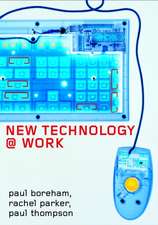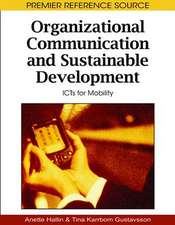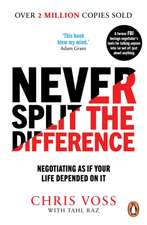The Inmates Are Running the Asylum
Autor Alan Cooperen Limba Engleză Paperback – 23 feb 2004
- EWeek lists Alan Cooper, the father of Visual Basic, as the #2 Mover and Shaker in a list of the 25 most influential people in technology-#1 was President George W. Bush.
- New edition supported by strong publicity and marketing campaign including endorsements from leaders in the industry and press reviews.
- Reveals the dark underbelly of software user interface development.
Preț: 165.99 lei
Preț vechi: 207.49 lei
-20% Nou
31.76€ • 33.16$ • 26.29£
Carte disponibilă
Livrare economică 15-29 martie
Livrare express 01-07 martie pentru 24.90 lei
Specificații
ISBN-10: 0672326140
Pagini: 288
Dimensiuni: 156 x 235 x 15 mm
Greutate: 0.4 kg
Ediția:Nouă
Editura: Sams Publishing
Locul publicării:Indianapolis, United States
Descriere
Cuprins
Foreword.
I. COMPUTER OBLITERACY.
1. Riddles for the Information Age.
What Do You Get When You Cross a Computer with an Airplane? What Do You Get When You Cross a Computer with a Camera? What Do You Get When You Cross a Computer with an Alarm Clock? What Do You Get When You Cross a Computer with a Car? What Do You Get When You Cross a Computer with a Bank? Computers Make It Easy to Get into Trouble. Commercial Software Suffers, Too. What Do You Get When You Cross a Computer with a Warship? Techno-Rage. An Industry in Denial. The Origins of This Book. 2. Cognitive Friction.
Behavior Unconnected to Physical Forces. Design Is a Big Word. The Relationship Between Programmers and Designers. Most Software Is Designed by Accident. "Interaction" Versus "Interface" Design. Why Software-Based Products Are Different. The Dancing Bear. The Cost of Features. Apologists and Survivors. How We React to Cognitive Friction. The Democratization of Consumer Power. Blaming the User. Software Apartheid.II. IT COSTS YOU BIG TIME.
3. Wasting Money.
Deadline Management. What Does "Done" Look Like? Parkinson's Law. The Product That Never Ships. Shipping Late Doesn't Hurt. Feature-List Bargaining. Programmers Are in Control. Features Are Not Necessarily Good. Iteration and the Myth of the Unpredictable Market. The Hidden Costs of Bad Software. The Only Thing More Expensive Than Writing Software Is Writing Bad Software. Opportunity Cost. The Cost of Prototyping. 4. The Dancing Bear.
If It Were a Problem, Wouldn't It Have Been Solved by Now? Consumer Electronics Victim. How Email Programs Fail. How Scheduling Programs Fail. How Calendar Software Fails. Mass Web Hysteria. What's Wrong with Software? Software Forgets. Software Is Lazy. Software Is Parsimonious with Information. Software Is Inflexible. Software Blames Users. Software Won't Take Responsibility. 5. Customer Disloyalty.
Desirability. A Comparison. Time to Market.III. EATING SOUP WITH A FORK.
6. The Inmates Are Running the Asylum.
Driving from the Backseat. Hatching a Catastrophe. Computers Versus Humans. Teaching Dogs to Be Cats. 7. Homo Logicus.
The Jetway Test. The Psychology of Computer Programmers. Programmers Trade Simplicity for Control. Programmers Exchange Success for Understanding. Programmers Focus on What Is Possible to the Exclusion of What Is Probable. Programmers Act Like Jocks. 8. An Obsolete Culture.
The Culture of Programming. Reusing Code. The Common Culture. Programming Culture at Microsoft. Cultural Isolation. Skin in the Game. Scarcity Thinking. The Process Is Dehumanizing, Not the Technology.IV. INTERACTION DESIGN IS GOOD BUSINESS.
9. Designing for Pleasure.
Personas. Design for Just One Person. The Roll-Aboard Suitcase and Sticky Notes. The Elastic User. Be Specific. Hypothetical. Precision, Not Accuracy. A Realistic Look at Skill Levels. Personas End Feature Debates. Both Designers and Programmers Need Personas. It's a User Persona, Not a Buyer Persona. The Cast of Characters. Primary Personas. Case Study: Sony Trans Com's P@ssport. The Conventional Solution. Personas. Designing for Clevis. 10. Designing for Power.
Goals Are the Reason Why We Perform Tasks. Tasks Are Not Goals. Programmers Do Task-Directed Design. Goal-Directed Design. Goal-Directed Television News. Goal-Directed Classroom Management. Personal and Practical Goals. The Principle of Commensurate Effort. Personal Goals. Corporate Goals. Practical Goals. False Goals. Computers Are Human, Too. Designing for Politeness. What Is Polite? What Makes Software Polite? Polite Software Is Interested in Me. Polite Software Is Deferential to Me. Polite Software Is Forthcoming. Polite Software Has Common Sense. Polite Software Anticipates My Needs. Polite Software Is Responsive. Polite Software Is Taciturn About Its Personal Problems. Polite Software Is Well Informed. Polite Software Is Perceptive. Polite Software Is Self-Confident. Polite Software Stays Focused. Polite Software Is Fudgable. Polite Software Gives Instant Gratification. Polite Software Is Trustworthy. Case Study: Elemental Drumbeat. The Investigation. Who Serves Whom. The Design. Pushback. Other Issues. 11. Designing for People.
Scenarios. Daily-Use Scenarios. Necessary-Use Scenarios. Edge-Case Scenario. Inflecting the Interface. Perpetual Intermediates. "Pretend It's Magic". Vocabulary. Breaking Through with Language. Reality Bats Last. Case Study: Logitech ScanMan. Malcolm, the Web-Warrior. Chad Marchetti, Boy. Magnum, DPI. Playing "Pretend It's Magic". World-Class Cropping. World-Class Image Resize. World-Class Image Reorient. World-Class Results. Bridging Hardware and Software. Less Is More.V. GETTING BACK INTO THE DRIVER'S SEAT.
12. Desperately Seeking Usability.
The Timing. User Testing. User Testing Before Programming. Fitting Usability Testing into the Process. Multidisciplinary Teams. Programmers Designing. How Do You Know? Style Guides. Conflict of Interest. Focus Groups. Visual Design. Industrial Design. Cool New Technology. Iteration. 13. A Managed Process.
Who Really Has the Most Influence? The Customer-Driven Death Spiral. Conceptual Integrity Is a Core Competence. A Faustian Bargain. Taking a Longer View. Taking Responsibility. Taking Time. Taking Control. Finding Bedrock. Knowing Where to Cut. Making Movies. The Deal. Document Design to Get It Built. Design Affects the Code. Design Documents Benefit Programmers. Design Documents Benefit Marketing. Design Documents Help Documenters and Tech Support. Design Documents Help Managers. Design Documents Benefit the Whole Company. Who Owns Product Quality? Creating a Design-Friendly Process. Where Interaction Designers Come From. Building Design Teams. 14. Power and Pleasure.
An Example of a Well-Run Project. A Companywide Awareness of Design. Benefits of Change. Let Them Eat Cake. Changing the Process. Index.
Notă biografică
His determination paid off. In 1990 he founded Cooper, a technology product design firm. Today, Cooper's innovative approach to software design is recognized as an industry standard. Over a decade after Cooper opened its doors for business, the San Francisco firm has provided innovative, user-focused solutions for companies such as Abbott Laboratories, Align Technologies, Discover Financial Services, Dolby, Ericsson, Fujitsu, Fujitsu Softek, Hewlett Packard, Informatica, IBM, Logitech, Merck-Medco, Microsoft, Overture, SAP, SHS Healthcare, Sony, Sun Microsystems, the Toro Company, Varian and VISA. The Cooper team offers training courses for the Goal-Directed® interaction design tools they have invented and perfected over the years, including the revolutionary technique for modeling and simulating users called personas, first introduced to the public in 1999 via the first edition of The Inmates.
In 1994, Bill Gates presented Alan with a Windows Pioneer Award for his invention of the visual programming concept behind Visual Basic, and in 1998 Alan received the prestigious Software Visionary Award from the Software Developer's Forum. Alan introduced a taxonomy for software design in 1995 with his best-selling first book, About Face: The Essentials of User Interface Design. Alan and co-author Robert Reimann published a significantly revised edition, About Face: The Essentials of Interaction Design, in 2003.
Alan's wife, Susan Cooper, is President and CEO of Cooper. They have two teenage sons, Scott and Marty, neither of whom is a nerd. In addition to software design, Alan is passionate about general aviation, urban planning, architecture, motor scooters, cooking, model trains and disc golf, among other things. Please send him email at inmates@cooper.com or visit Cooper's Web site at http://www.cooper.com.
Textul de pe ultima copertă
Imagine, at a terrifyingly aggressive rate, everything you regularly use is being equipped with computer technology. Think about your phone, cameras, cars-everything-being automated and programmed by people who in their rush to accept the many benefits of the silicon chip, have abdicated their responsibility to make these products easy to use. "The Inmates Are Running the Asylum" argues that the business executives who make the decisions to develop these products are not the ones in control of the technology used to create them. Insightful and entertaining, "The Inmates Are Running the Asylum" uses the author's experiences in corporate America to illustrate how talented people continuously design bad software-based products and why we need technology to work the way average people think. Somewhere out there is a happy medium that makes these types of products both user and bottom-line friendly; this book discusses why we need to quickly find that medium.





















